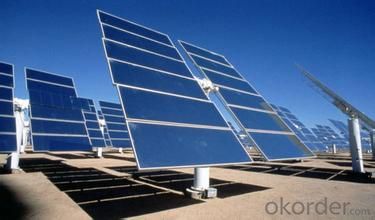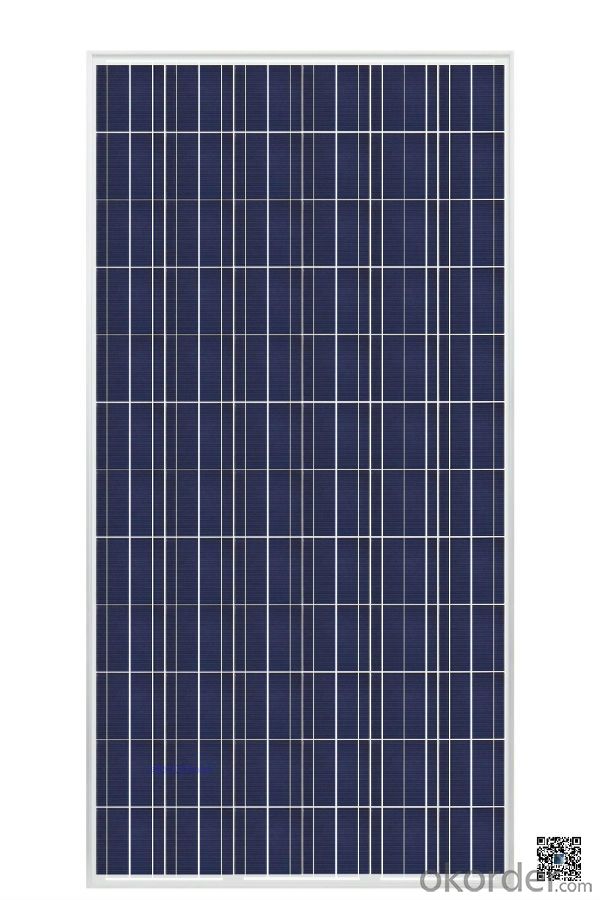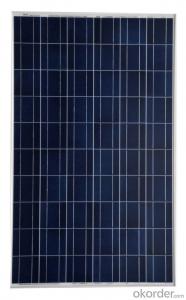SOLAR PANELS,SOLAR PANEL IN STOKE ,SOLAR MODULE PANEL WITH HIGH EFFICENCY
- Loading Port:
- Shanghai
- Payment Terms:
- TT OR LC
- Min Order Qty:
- 2500 watt
- Supply Capability:
- 26000 watt/month
OKorder Service Pledge
OKorder Financial Service
You Might Also Like
Item specifice
We now provide
• Monocrystalline Solar Panel
• Polycrystalline Solar Panel( multicrystalline silicon Solar Panel)
Features of our products:
• High conversion efficiency mono/poly-crystalline amorphous silicon solar cells
• Modules incorporate high performance bypass diodes to minimize the power drop caused by shading
• High transmittance, low-iron tempered glass
• High performance EVA encapsulant to prevent destroying and water.
• AI frame: without screw, corner connection. 8 holes on the frame can be installed easily
• Good performance of preventing from atrocious weather such as wind and hails



Polycrystalline Silicon Solar Modules 48Cell-195W Specification
ELECTRICAL PERFORMANCE | |||
Power output | P max | W | 195 |
Power output tolerances | ΔP max | W | 0/+5 |
Module effi ciency | η m | % | 14.7 |
Voltage at Pmax | V mpp | V | 23.7 |
Current at Pmax | I mpp | A | 8.03 |
Open-circuit voltage | V oc | V | 30.1 |
Short-circuit current | I sc | A | 8.65 |
Product Description:
This installation Manual contains essential information for the electrical and mechanical installation that your must know before installing CUSTOMER PV modules. This also contains safety information you need to be familiar with .All the information described in this manual are the intellectual property of CNBM and based on the technologies and experiences that have been acquired and accumulated in the long history of CUSTOMER. This document does not constitute a warranty, expressed or implied.
CUSTOMER does not assume responsibility and expressly disclaims liability for loss, damage, or expense arising out of in anyway connected with installation, operation, use or maintenance of the PV modules. No responsibility is assumed by CUSTOMER for any infringement of patents or other rights of third parties that may result from use of PV module.
CUSTOMER reserves the right to make changes to the product, specifications or installation manual without prior notice.
Solar panel working process
In addition to being the ultimate source of all life on earth, the sun is an infinitely renewable, completely pollution-free source of electricity. Instead of burning fossil fuels dug up from the ground in a big power plant – a very 19th century, industrial age approach, when you think about it – solar panels convert sunlight directly into electricity, with no harmful emissions.
The basic unit of a solar panel is a solar cell, which usually consists of one or two layers of silicon-based semiconductor wafers. When struck by the photons in sunlight, the solar cell generates an electrical charge due to the "photovoltaic effect" – which is a pretty good name, since it produces voltage from photons. The flow of these electrons moves in a steady electrical current from one side of the cell to the other.
Dozens of these PV cells are packaged together into solar modules, which in turn are packaged into solar panels that are mounted on a rooftop and arranged to maximize their hours of exposure to direct sunlight. Because the electricity generated by all those solar cells is direct current (DC), it is then sent to an inverter that transforms the power into the same alternating current (AC) used by the appliances in your home and the local utility electricity distribution grid. Increasingly, these inverters are getting "smart," providing data monitoring for solar installation performance and other grid integration services.
- Q:Can solar panels be installed on data centers or IT facilities?
- Yes, solar panels can be installed on data centers or IT facilities. In fact, many data centers and IT facilities are increasingly adopting solar energy as a sustainable and cost-effective power source. Solar panels can be installed on rooftops or in open areas surrounding the facility to generate clean electricity and reduce their reliance on traditional grid power.
- Q:Can solar panels be used for powering a research facility or laboratory?
- Yes, solar panels can be used to power a research facility or laboratory. Solar panels convert sunlight into electricity, providing a sustainable and renewable source of power. By harnessing solar energy, research facilities and laboratories can reduce their reliance on traditional energy sources and contribute to a greener and more environmentally friendly operation. Additionally, solar panels can be integrated into the existing infrastructure of the facility, making them a viable option for powering various scientific equipment and systems.
- Q:I'm looking to see how much it would be to install solar panels on a home. Or more information on where i would be able to locate a place of purchase, or in general more information...
- A Solar panel usually cost between $0,000-20,000 and more. If you're not wanting to spend that much, I suggest you try the DIY solar panel guides. These are step-by-step guides in building solar panels. They are very cheap and overall, you can get solar panels for less than $200. The guide will help you choose where to buy and what to buy so you won't spend thousands of dollars. Whether you're a beginner or an expert, you can do it. If you're interested, just click on the link below. I also added some links where you can read reviews about these guides. Goodluck!
- Q:I'm looking for some advice on hot water solar panels. I'm trying to save some money on electricity. A neighbor has been suggesting solar powered equipment for some time now, and I think he's right. It does save quite a bit of money in the long run. They're kind of expensive though, so I'm looking for cheaper alternatives.
- Solar Power is great. I installed it myself about 2 years ago, and you really do notice the change within the first couple months. Building it yourself is actually pretty tricky without the right resources. Some of the guides don't have enough detailed information that you need when you start putting the project together. I was having a lot of trouble until I stumbled upon a site that was offering some great resources for solar DIY projects. I went ahead and added it to the sources section below. It's great and has everything you would need for putting your own solar projects together, including hot water solar panels. Hope this helps!
- Q:Basically I need a custom solar panel created. I won't go into detail but the dimensions need to be around 4''x2.5'' and be as thin as possible.
- There's no way that home built system that will generate enough power to run your home off the grid. That's all hogwash! No wind = no electricity generated. No sun = no electricity generated. I'm looking into a grid tie solar system. I'm still working out the math for my home. They are expensive ($20k - $50k) before tax credits, but they have been designed by engineers, not back yard, shade tree wanna-be engineers. They will put power into the grid during the day (making your meter run backwards) and you'll draw the power back at night (when there's no sun). This is perfectly legal. It must be installed by power company approved techs. That's how power companies are going to meet their green energy mandates for the future. You'll generate power for the power company and get paid wholesale prices for it (during the day). But you'll buy it back at retail (at night)
- Q:Are there government incentives for installing solar panels?
- Yes, many governments provide incentives for installing solar panels. These incentives can include tax credits, grants, rebates, and low-interest loans to encourage individuals and businesses to adopt solar energy.
- Q:Can solar panels be installed on restaurants or food establishments?
- Yes, solar panels can be installed on restaurants or food establishments. In fact, many food establishments have started to embrace solar energy as a sustainable and cost-effective solution to power their operations. Installing solar panels on rooftops or in parking lots can help these establishments reduce their carbon footprint, lower energy costs, and demonstrate their commitment to environmental sustainability.
- Q:Can solar panels be used to power a bank?
- Yes, solar panels can be used to power a bank. Solar panels can generate electricity by converting sunlight into energy, which can then be used to power various electrical systems, including those in a bank. By installing solar panels on the roof or surrounding areas of a bank, it is possible to generate clean and renewable energy that can offset the bank's electricity consumption and reduce its carbon footprint.
- Q:What is the difference between monocrystalline and polycrystalline solar panels?
- Monocrystalline solar panels are made from a single crystal structure, resulting in higher efficiency and performance but at a higher cost. Polycrystalline solar panels are made from multiple crystal structures, which lowers their efficiency slightly but also reduces their cost.
- Q:What things can a solar panel power?
- if you have 0 big panel eg: say of 200watts and have 6 hours of proper sunlight.. so u will have 2000watts of energy 2Kw of energy per day.. it depends what is ur household usage.. a 00W bulb for 6hrs= 600W a TV may be 400W for 8 hrs =3200watts.. calculate like this for each equipment u have.. or ucan calculate ur daily use from ur meter... also u need enough batteries for storage and an inverter to covert the DC energy to AC energy.. solar can power anything if it is efficiently stored and generated... depends on the no of panels u have ..area you have for installation......... the cost u can afford.. a 200W solar panel may cost 35000 - 40000 in india..
1. Manufacturer Overview |
|
|---|---|
| Location | |
| Year Established | |
| Annual Output Value | |
| Main Markets | |
| Company Certifications | |
2. Manufacturer Certificates |
|
|---|---|
| a) Certification Name | |
| Range | |
| Reference | |
| Validity Period | |
3. Manufacturer Capability |
|
|---|---|
| a)Trade Capacity | |
| Nearest Port | |
| Export Percentage | |
| No.of Employees in Trade Department | |
| Language Spoken: | |
| b)Factory Information | |
| Factory Size: | |
| No. of Production Lines | |
| Contract Manufacturing | |
| Product Price Range | |
Send your message to us
SOLAR PANELS,SOLAR PANEL IN STOKE ,SOLAR MODULE PANEL WITH HIGH EFFICENCY
- Loading Port:
- Shanghai
- Payment Terms:
- TT OR LC
- Min Order Qty:
- 2500 watt
- Supply Capability:
- 26000 watt/month
OKorder Service Pledge
OKorder Financial Service
Similar products
New products
Hot products
Related keywords





























